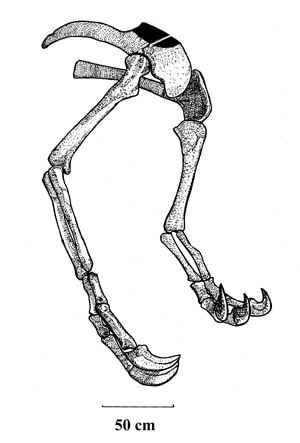
Species: mirificus OSMOLSKA & RONIEWICZ, 1970
Etymology: Latin, mirificus, "unusual, peculiar"; in reference to the unsual
structure of the fore limb.
Holotype: ZPAL MgD-I/6
Locality: Altan Ula III, Nemegt Basin, Ömnögov (South Gobi), Mongolia.
Horizon: Upper Nemegt Formation.
Biostratigraphy: Tarbosaurus bataar, Saurolophus angustirsotris and Dyoplosaurus giganteus Zone.
Age: Late Campanian or Early Maastrichtian Stage, Senonian Subepoch, Gulf Epoch, Late Cretaceous.
Material: Shoulder girdle and fore limbs, fragmentary vertebrae and ribs.
Note: Palaeopathologies, left manual phalanges III-1 and III-2 bear pits, presumably
from an injury to the joint between them.

Note: Tooth marks were found on the bones of Deinocheirus (BELL, CURRIE, & LEE, 2013)
Referred material:
LEE, BARSBOLD, CURRIE, KOBAYASHI, LEE, GODEFROIT, ESCUILLE, & CHINZORIG, 2014
Locality: Altan Uul IV, Nemegt Basin, Ömnögov (South Gobi), Mongolia.
Horizon: Upper Nemegt Formation.
Biostratigraphy: Tarbosaurus bataar, Saurolophus angustirsotris and Dyoplosaurus giganteus Zone.
Age: Late Campanian or Early Maastrichtian Stage, Senonian Subepoch, Gulf Epoch, Late Cretaceous.
Material:
MPC-D 100/128: Skull and fragmentary skeleton.
Deinocheirus mirificus (after LEE, et al., 2014), MPC-D 100/128.
Locality: Bugiin Tsav, Nemegt Basin, Ömnögov (South Gobi), Mongolia.
Horizon: Upper Nemegt Formation.
Biostratigraphy: Tarbosaurus bataar, Saurolophus angustirsotris and Dyoplosaurus giganteus Zone.
Age: Late Campanian or Early Maastrichtian Stage, Senonian Subepoch, Gulf Epoch, Late Cretaceous.
Material:
MPC-D 100/127: Fragmentary skeleton.